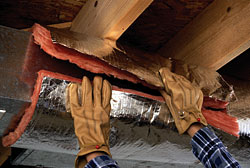
The most serious question raised is whether glass fibers could cause cancer through inhalation, either during the manufacturing process or while working with the material. Members of the North American Insulation Manufacturers Association (NAIMA) argue this question has been answered through extensive research, and cite experts who assert you have to physically plant a lot of glass fibers into a lab rat's chest cavity to cause cancerous cell growth. Fiberglass particles that are inhaled normally are broken down safely like household dust, studies show.
The problem is getting the government to officially reclassify this material as noncancerous. Until that happens, manufacturers and others worry litigation-weary engineers and architects may shy away from specifying it.
Moving Slowly
Paul Newton calls the slowness of the federal Department of Health and Human Services "your tax dollars at work."Newton is the manager of advertising and promotions at CertainTeed Corp., Valley Forge, Pa. He and other members of the manufacturing community have been waiting for the reclassification of fiberglass as a noncarcinogen.
In the 1980s, both asbestos and fiberglass were examined for carcinogenic effects. According to Newton, fibers from both materials have been closely examined for carcinogicity.
In 1994, Health and Human Service's National Toxicology Program (NTP, Research Triangle Park, N.C.) listed fiberglass as being "reasonably anticipated to be a human carcinogen" based on animal test data.
Early research of fiberglass that led to its classification as a carcinogen did not use real-world exposure paths, Newton said. "In the original studies that lead to the classification, researchers opened up lab animals and implanted fibers in chest cavities," he said.
In 1999, OSHA and NAIMA, voluntarily agreed on ways to control workplace exposure to avoid irritation. As a result, OSHA agreed not to regulate exposure to fiberglass insulation.
In 2000, the National Academy of Sciences (NAS) reported that among fiberglass manufacturing workers, "glass fibers do not appear to increase the risk of respiratory system cancer."
In 2001, the International Agency for Research on Cancer (IARC) revised its previous classification of glass wool being a possible carcinogen, pointing out that newer man-made fibers have been developed specifically to replace asbestos and other "bio-persistent" products used in home building. (The slow breakdown of those older materials equated to their higher carcinogenic risks, the agency said.)
"Some of these newer materials have now been tested for carcinogenicity and most are found to be noncarcinogenic, or to cause tumours in experimental animals only under very restricted conditions of exposure," stated IARC.
Fiberglass "is currently considered not classifiable as a human carcinogen," stated the American Lung Association (ALA). "Studies done in the past 15 years since the previous report was released do not provide enough evidence to link this material to any [lung] cancer [or mesothelioma] risk."
Mind you, the stuff still itches. People who work with it need to protect their eyes, cover their skin, and wash their work clothes separately from the rest of the family's laundry. They need to change clothes as soon after work as they can.
"Although IARC is located in Europe, the reclassification has not resulted in any changes in the EU because it had already been treated as such under the EU's classification scheme," said Jim Worden, director of corporate communications, environment health and safety, Owens Corning, Toledo, Ohio.
"In the United States, the next step is for the NTP to review the science that IARC considered and decide whether to change its classification, which is currently ‘reasonably anticipated to be carcinogenic,'" Worden said. "Although that process has already begun, we do not anticipate that it will be completed until 2006. The same research would likely be reviewed at some later date by the state of California" for Proposition 65, the Safe Drinking Water and Toxic Enforcement Act of 1986.
In general, "fiberglass went from possible carcinogen to nonclassifiable, which is a step in the right direction," Worden said. He also pointed out that permissible exposure limits to fiberglass particles have not changed. They remain 1 respirable fiber per cubic centimeter of air.
Sidebar: Handling Fiberglass Without The Itch
According to the North American Insulation Manufacturers Association (NAIMA), "Fiberglass is now the most thoroughly evaluated insulation material in the market. Scientific evidence demonstrates that fiberglass is safe to manufacture, install, and use when recommended work practices are followed. Following these work practices will help to reduce irritation." These include:NAIMA also recommends following these safe work practices for handling synthetic vitreous fiber (SVF or fiberglass) products.
Minimize Dust Generation
Maintain Adequate Ventilation
Dress Appropriately
Removing Fibers
For more information, contact NAIMA, 44 Canal Center Plaza, Ste. 310, Alexandria, VA 22314; 703-684-0084; www.naima.org.
Sidebar: Safe Duct Removal
"These recommended practices are applicable for workers removing synthetic vitreous fiber (SVF) products during significant repair or demolition activity," stated the North American Insulation Manufacturers Association (NAIMA). "Additional precautions may be required if workers are also exposed to other products or substances. In such circumstances, more stringent recommendations may apply."Recommended practices include:
For additional information, contact NAIMA, 44 Canal Center Plaza, Ste. 310, Alexandria, VA 22314; 703-684-0084; 703-684-0427 (fax); www.naima.org.
Publication date: 10/25/2004
